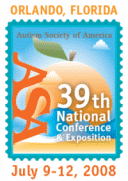 |
The ASA's 39th National Conference on Autism Spectrum Disorders of ASAThe Westin Kierland Resort & Spa, Scottsdale, AZ |
| For a complete author index with session numbers, please click here | |
| Friday, July 11, 2008: 1:45 PM-3:00 PM | |||
| Tallahassee 2 | |||
| #3622- Visual Support for Children with ASD: Comparison of Static Vs. Animated Stimuli (1.5 BCBA continuing education units available) | |||
| Both static visual symbols and animated visual symbols have been shown to be beneficial for supporting the learning of students with ASD; Differential effectiveness has not been explored. For this reason, two studies were conducted to evaluate the relative effectiveness of pictures and videos on two sets of skills with two groups of children. In this session the presenter will describe the outcomes of those studies and discuss implications for teachers in terms of effectiveness for promoting learning. | |||
| Presenter: | - My experience includes teaching in the public schools, preschool through 12th grade, setting up home programs, training teachers, consultants, and therapists and consulting to school systems in the Savannah area. I am a board certified behavior analyst and assistant professor at Armstrong Atlantic State University. | ||
|
| |||
|
Individuals with autism spectrum disorders (ASD) are described as having relative strengths in visual-spatial processing as compared to auditory processing. Subsequently, most teachers provide high levels of visually presented information in instructional contexts. Visual supports are used to prompt, prepare, preview, and review behavioral and social expectations. Two visually based interventions that have been studied with students with ASD are static visual symbols and animated visual symbols (i.e., video modeling). Static visual symbols, including icons, words, and pictures, can depict steps in a task remaining time, or illustrate behavioral expectations. Visual stimuli provide concrete images that remain in sight to circumvent potential problems with auditory processing and memory. Static visual cues have been used with individuals with ASD to increase conversational skills, play skills and transitioning. Picture prompts also have been used to support on-task behavior. Unlike static visual symbols, video modeling presents information visually but the information does not persist in the environment. However, the video model can provide a distraction-free depiction of skills in a motivational format and can be replayed multiple times. Video modeling has been found to be effective for teaching purchasing skills to individuals with ASD, perspective taking, conversational skills, play behavior, and functional living skills. Although both static visual symbols and animated visual symbols have been shown to be beneficial for supporting the learning of students with ASD, differential effectiveness has not been explored. For this reason, two studies were conducted to evaluate the relative effectiveness of pictures and videos on two sets of skills with two groups of children. In the first study, four preschool children with ASD were taught to identify body parts. In the second study, four elementary-aged boys with autism were taught to request leisure items. Both studies used an alternating treatment with replication within a multiple probe design across participants to compare the use of static pictures and video modeling to determine if one method was more efficient that the other. Presenters will describe outcomes of those e studies and discuss implications for teachers in terms of effectiveness for promoting learning and ease of implementation. |
|||
See more of General Submissions
See more of The ASA's 39th National Conference on Autism Spectrum Disorders